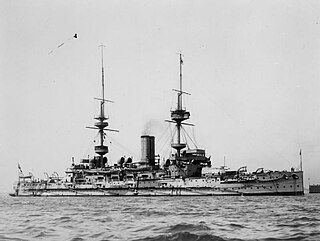
The third HMS Illustrious of the British Royal Navy was a Majestic-class pre-dreadnought battleship. The ship was built at the Chatham Dockyard; her keel was laid down in March 1895, her completed hull was launched in September 1896, and she was commissioned into the fleet in April 1898. She was armed with a main battery of four 12-inch (305 mm) guns and a secondary battery of twelve 6-inch (152 mm) guns. The ship had a top speed of 16 knots.
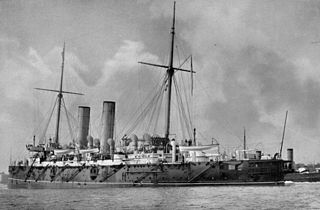
HMS Gibraltar, was an Edgar-class cruiser launched in 1892 for service in the Royal Navy. She was built and engineered by Messrs Napier of Glasgow. Of 7,700 loaded displacement, she was coal-fired with four double-ended cylindrical boilers driving two shafts. She could make 20 knots (37 km/h) with forced draught and 18 knots (33 km/h) with natural draught. She was a very good sea boat and an exceptional steamer.

HMS Warspite was an Imperieuse-class first-class armoured cruiser, launched on 29 January 1884 and commissioned in 1886.

HMS Camperdown was an Admiral-class battleship of the Royal Navy, named after Adam Duncan, 1st Viscount Duncan of Camperdown.
HMS Electra was a Clydebank-built, three-funnelled, 30-knot destroyer ordered by the Royal Navy under the 1895–1896 Naval Estimates. She was the fourth ship to carry this name since it was introduced in 1806 for a 16-gun brig-sloop.

Admiral Sir Archibald Lucius Douglas, was a Royal Navy officer of the 19th century.

HMS Revenge was one of seven Royal Sovereign-class pre-dreadnought battleships built for the Royal Navy during the 1890s. She spent much of her early career as a flagship for the Flying Squadron and in the Mediterranean, Home and Channel Fleets. Revenge was assigned to the International Squadron blockading Crete during the 1897–1898 revolt there against the Ottoman Empire. She was placed in reserve upon her return home in 1900, and was then briefly assigned as a coast guard ship before she joined the Home Fleet in 1902. The ship became a gunnery training ship in 1906 until she was paid off in 1913.

HMS Royal Arthur was a first class cruiser of the Edgar class, previously named Centaur, but renamed in 1890 prior to launching. She served on the Australia Station and briefly on the North America and West Indies Station before returning to the Home Fleet in 1906. She was paid off after the First World War.

HMS Crescent was a first class cruiser of the Edgar class in the British Royal Navy. Crescent, and her sister ship Royal Arthur, were built to a slightly modified design and are sometimes considered a separate class. She was launched in 1892, saw early service at the Australia Station and the North America and West Indies Station, served in the First World War, and was sold for breaking up in 1921.
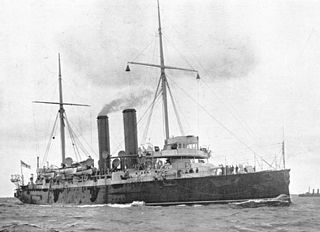
HMS St George was a first class cruiser of the Edgar class. She was launched on 23 June 1892.
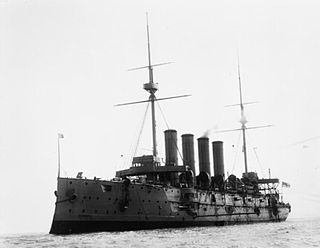
HMS Diadem was the lead ship of the Diadem-class of protected cruiser in the Royal Navy.

HMS Amphitrite was a ship of the Diadem-class of protected cruisers in the Royal Navy, which served in the First World War.

HMS Andromeda was one of eight Diadem-class protected cruisers built for the Royal Navy in the 1890s. Upon completion in 1899, the ship was assigned to the Mediterranean Fleet where she helped to escort a royal yacht during its cruise through the Mediterranean Sea. After a refit, she was assigned to the China Station in 1904 and returned home three years later to be reduced to reserve. Andromeda was converted into a training ship in 1913 and remained in that role under various names until 1956. That year she was sold for scrap and broken up in Belgium, the last Pembroke-built ship still afloat.

HMS Argonaut was a ship of the Diadem-class of protected cruiser in the British Royal Navy. She was laid down in 1898, and commissioned for service on the China station in 1900. From 1906 she served in the Home Fleet, and during the First World War she served in the Atlantic. She was converted to hospital ship in 1915, and sold for breaking up in 1920.

HMS Europa was a ship of the Diadem-class protected cruisers in the Royal Navy. She was built by J&G Thompson of Clydebank and launched on 20 March 1897.
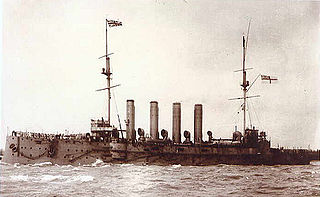
HMS Spartiate was a ship of the Diadem-class protected cruisers in the Royal Navy. She was built at Pembroke Dock and launched on 27 October 1898. She was a stokers' training ship in 1914 and was renamed Fisgard in June 1915. She survived the First World War and was sold in July 1932. She returned to Pembroke to be broken up.
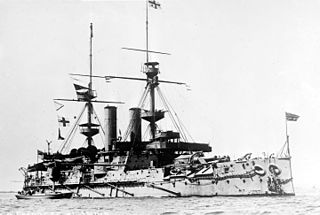
HMS Empress of India was one of seven Royal Sovereign-class pre-dreadnought battleships built for the Royal Navy during the 1890s. The ship was commissioned in 1893 and served as the flagship of the second-in-command of the Channel Fleet for two years. She was transferred to the Mediterranean Fleet in 1897, during which time Empress of India was assigned to the International Squadron blockading Crete during the uprising there. She returned home in 1901 and was briefly assigned as a coast guard ship in Ireland before she became the second flagship of the Home Fleet. The ship was reduced to reserve in 1905 and accidentally collided with the submarine HMS A10 the following year. Empress of India was taken out of service in early 1912 and accidentally struck a German sailing ship while under tow. She was sunk as a target ship in 1913.

HMS Angler was a two-funnel, 30-knot destroyer ordered by the Royal Navy under the 1895 – 1896 Naval Estimates. She was the second ship to carry this name. She was launched in 1897, served at Chatham and Portsmouth and was sold for breaking in 1920.
Admiral Sir Frederic Edward Errington Brock, was a Royal Navy officer.
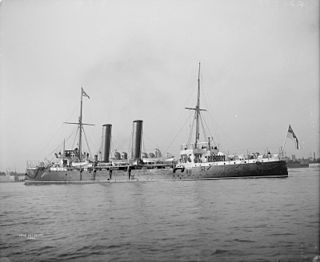
HMS Intrepid was an Apollo-class protected cruiser of the Royal Navy built on the River Clyde and launched in 1891. She was subsequently converted as a minelayer in the latter half of her career and ultimately sunk as a blockship during the Zeebrugge Raid on 23 April 1918.



















